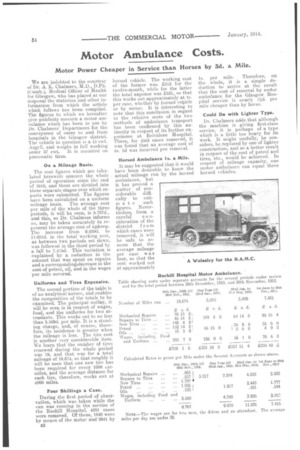Motor Ambulance Costs.
Page 56

If you've noticed an error in this article please click here to report it so we can fix it.
Motor Power Cheaper in Service than Horses by 3d. a Mile.
We are indebted to the courtesy of Dr. A. K. Chalmers, M.D., D.Ph. (Camb.), Medical Offieer of Health for Glasgow, who has placed at our disposal the statistics and other information from which the article which follows has been compiled. The figures to which we hereafter give publicity'concern a motor amoulance which has been in use by (Jr.. Chalmers' Department for the conveyance of cases to and from hospitals in the Glasgow district. The vehicle in question is a 15 cwt. Argyll, and weighs in full working oecier 37 cwt. It is mounted on pneumatic tires.
Oa a Mileage Basis.
The cost figures which are tabukited herewith concern the whole period of operation since the end of 1910, and these are divided into three separate stages over which reports were submitted. The figures have been calculated on a uniform mileage basis. The average cost per mile of the whole of the three periods, it will be seen, is 8.767d., aad this, so Dr. Chalmers informs us, may be taken accurately to represent the average cost of. upkeep. The increase from 9.039d. to 11.031d. in the total working cost, as between two periods set down, was followed in the third period by a fall to 7.415d. This variation is explained by a reduction in the amount that was spent on repairs and a corresponding)decrease in the cost of petrol, oil, and in the wages per mile covered.
Uniforms and Tires Expensive.
The second portion of tie table is of an analytical nature, and enables the composition of the totals to be examined. The principal outlay, it will be seen is in respect of wages, food, and the uniforms for two attendants. This works out to no less than 3.569d. per mile. It is a standing charge, and, of course, therefore, its incidence is greater when the mileage is less. The tire cost is another very considerable item. We learn that the number of tires renewed during the whole period was 19, and that was for a total mileage of 19,674, so that roughly it will be seen that one new tire has been required for every 1000 earmiles' and the average distance for each tire, therefore, works out at 4000 miles.
Four Shillings a Case.
During the first period of observation, which was taken while the van was running in the service of the Ruchill Hospital, 4281 cases were removed. Of these, 1640 were by means of the motor and 2641 by 12 horsed vehicle. The working cost of the former was £332 for the twelve-month, while for the latter the total expense was £521, so that this works out approximately at 4s. per case, whether by horsed vehicle or by motor. It is interesting to note that this conclusion in regard to the relative costs of the two metfuxis of ambulance transport has been confirmed by this authority in respect of its further experience at Belvidere Hospital. There, for 4582 cases removed, it was found that an average cost of 9s. id was incurred per removal.
Horsed Ambulance ls. a Mile.
careful consideration of the district from which cases were removed, it will be safe to assume that the average mileage per case was four, so that the cost worked out at approximately
Is. per mile. Therefore, on the whole, it is a simple deduction to arrive at the result that the cost of removal by motor ambulance for the Glasgow Hospital service is nearly 3id. per mile cheaper than by horse.
Could Do with Lighter Type.
Dr. Chalmers adds that although the machine is giving first-class service, it is perhaps of a type which is a little too heavy for its work. It might usefully, he considers, be replaced by one of lighter construction, and so a better result in respect of the cost of petrol and tires, etc., would be achieved. In respect of mileage capacity, one motor ambulance can equal three horsed vehicles.






















































































